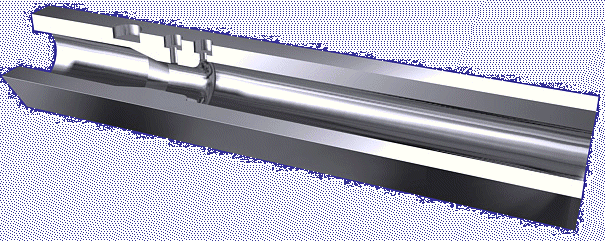Measuring principle with pressure regain / Measuring precision and calibration
Foreword
With the introduction of digital technology, the knowledge and handling of nozzles
went almost lost a few decades ago. Almost all saw the future in the calorimetric principle and the ultrasonic
measuring technique. The reason was that these techniques were cheap and easy to digitalize and it was
thought that it was only a matter of time and of some further technical development to reach a point where
the results would eventually become more accurate and reliable.
Only recently many customers and manufacturers have learned that this was, if not a fallacy, then at least
just wishful thinking. By their physical principles, there is no way to reach an accuracy of better than
4 - 5% of the measured value.
One of the reasons for this is that these devices typically only determine one point-like flow velocity.
A volume flow derived from this is usually wrong, because the volume flow requires in fact the integral
of infinitesimally small (and many) individual flow velocities distributed over the entire line's
cross-section.
The volume flow measuring device consists of a measuring nozzle (which
is selected in accordance with the measuring range), a microprocessor-controlled
display / control unit and the connecting cables and hoses.
When gas or air enters the specially designed nozzles it flows
through a cross-sectional constriction, causing the pressure to drop
slightly. The pressure in front of the constriction and in the
constriction is then measured. The current calibrated volume flow is
calculated from the slight difference in the two measured values
(effective pressure).
Because each change in volume flow leads to an immediate response
of the pressure sensors, which actually react very fast, there is no
problem at all to measure short, transient
consumption peaks or pulsating volume flows as well. See also
fast short-time measurements in the software section.
It is, by the way, a wide-spread misunderstanding to think
that the effective pressure within the constriction would lead to an equally high,
remaining pressure loss.
|
Right: Sectional view of an 1/2"- nozzle
|
 |
In fact the gas is accelerated by the Venturi-nozzle, but immediately after the nozzle
it is slowed down again by the more inert mainstream. During this process a more
than considerable pressure regain takes place.
It is proven by measurements in front of and behind the nozzle that even a full-scale
effective pressure of 350 mbar will only lead to an effective pressure loss of less
than 100 mbar.
As a rule of thumb one can assume 2.5 percent power loss for the downline
consumers if the operating pressure drops by 100 mbar. But this is, mind you,
just the absolutely worst case.
In practice there is usually no need to worry about
pressure losses while measuring with the VSM02 !
One reason for this is the availability of several measuring nozzles with
variable diameters and overlapping measuring ranges. Instead of measuring
a certain volume flow with a small nozzle (at high effective pressures) it
is possible to measure the flow simply with the next-large nozzle at
much lower effective pressures. (By the way,
the range switch of an amperemeter serves a very similar purpose, as you know).
On the other hand the VSM02 is a precision device which does
not, of course, need the full-scale effective pressure in order to
function properly. The VSM02 will rather make correct measurements with
effective pressures as low as 60 Pa (0.6 mbar).
For low effective pressures it has a resolution of approx. 1 Pa
(0.01 mbar).
An example:
at a line pressure of 6 bar a volume flow of, e.g., 350 Nm³/h
is measured with a 2"-nozzle at an effective pressure of approx.
10 mbar (1000 Pa). Due to the pressure regain the pressure loss is
further reduced to a maximum of 4 mbar. Despite the high volume flow
the line pressure was only reduced from 6.000 to 5.996 bar (equals
0.07 percent). The resulting power loss for the downline consumers
is therefore not higher than approx. 0.1
percent (!).
These almost loss-free measurements are one
of the main reasons for the excellent suitability of the VSM02
for use as a permanently installed consumption counter.
Volume flow rates are measured by the VSM02 with a
constant precision of +/- 2.5 % of the measured value.
By calculating the standardized
volume flow the measured results are independent from changes in
line pressure and gas temperature.
Besides we emphasize the fact that the constant measuring precision
applies to the measured value!
Some producers go without a clear specification of their measurement
deviation. Often this means a tacit drawback to a precision that only
applies to the full-scale range. This can make an enormous difference:
As you see, the relative deviation of the VSM02 is equal or less
than +/- 2.5 percent for all measured values.
Devices with the 'same' nominal deviation, but applied to the full-scale
value, would produce very unreliable results, especially for low
measured values! It may have been just this kind of test benches
which contributed in the past to the prejudice of 'high pressure losses'
for this measuring principle. The VSM02, however, is designed to
measure low values with the same precision as high values, therefore
it is always possible to get high quality measurements at an absolute
minimum of pressure losses.
|







